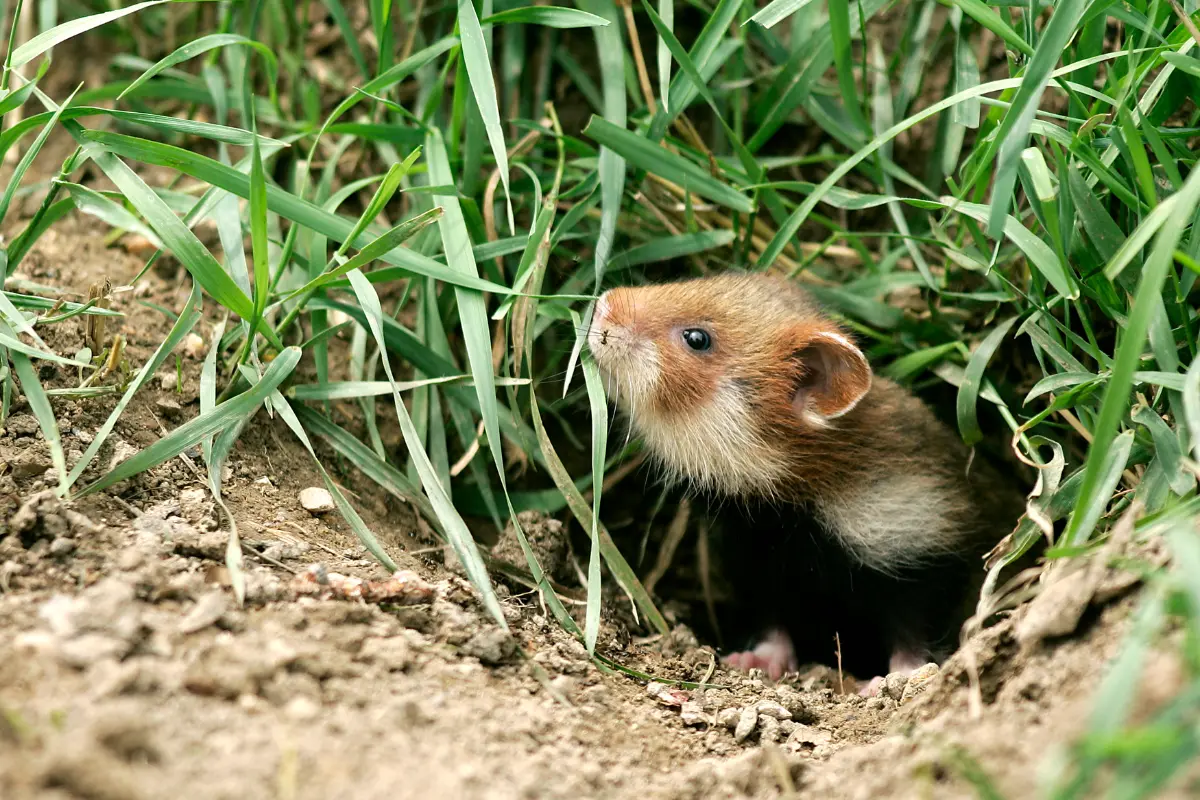Lost Hamster? Here’s Why They Escape & How to Bring Them Back
Losing track of a tiny, curious hamster can be a heart-stopping moment for any pet owner. One moment they’re safe in their cage, and the next, they’ve vanished without a trace. But don’t worry—lost hamsters are often closer than you think, and with the right approach, you can coax them back home safely.
Why Do Hamsters Try to Escape?
Here’s a detailed look at why hamsters might try to escape and how to prevent it.
1. Natural Instincts and Exploration
Hamsters are naturally curious and have a strong desire to explore their environment. In the wild, they’re used to covering significant distances in search of food, water, and shelter.
Domesticated hamsters retain this urge to explore, which can lead them to attempt an escape when confined to a cage. When your hamster tries to climb, gnaw on cage bars, or scratch at the corners, they’re likely acting out an innate drive to explore beyond their immediate surroundings.
Solution: Add Enrichment
- To satisfy their exploratory urges, create a more enriching environment with tunnels, hideouts, and items to climb on. Consider introducing a hamster-safe playpen where they can explore new areas under your supervision. Changing up toys regularly can also keep them stimulated and curious without the need to escape.
2. Insufficient Cage Space
One of the most common reasons for escape attempts is that the cage is too small. A cramped environment can make a hamster feel stressed, leading them to seek more space.
According to experts, a hamster’s cage should ideally be at least 450 square inches of floor space, though more is always better. Syrian hamsters especially need plenty of room due to their larger size.
Solution: Upgrade the Cage Size
- Ensure that your hamster’s cage meets or exceeds the recommended size guidelines. The larger the cage, the less likely your hamster is to become restless or feel the need to escape.
3. Inadequate Mental and Physical Stimulation
Hamsters are highly active animals that need mental and physical stimulation to stay healthy and happy. When they lack toys, climbing structures, and exercise options, they can become bored, which often results in escape behaviors. Bar-chewing, climbing, and scratching are all signs of boredom.
Solution: Provide Toys and a Running Wheel
- Provide various toys, such as wooden chew sticks, tunnels, and a hamster wheel with a solid surface to prevent injury. The wheel size should be appropriate for your hamster’s breed; for example, Syrians need a larger wheel, around 8-12 inches in diameter, while dwarf hamsters can use a smaller one. Rotating toys and rearranging the cage layout occasionally can also help keep them mentally stimulated.
4. Stress and Anxiety
Hamsters can experience stress from factors such as loud noises, excessive handling, or a lack of hiding places in their cage. If your hamster is consistently feeling stressed, it may try to escape to a perceived “safe” environment. Signs of stress in hamsters include excessive grooming, freezing, and hiding, as well as escape behaviors.
Solution: Reduce Stressors
- Keep your hamster’s cage in a quiet area away from loud noises and sudden disturbances. Limit handling, especially if your hamster is still adjusting to its new environment. Ensure there are plenty of hideouts where they can retreat when they feel stressed.
5. Desire for Social Interaction (or Lack of It)
While some hamsters, like dwarf breeds, are social and can live with companions, others, like Syrian hamsters, prefer solitude.
The presence of other animals or people can make a solitary hamster feel uncomfortable, which might drive them to escape. On the other hand, dwarf hamsters lacking interaction with companions may feel lonely and attempt to escape.
Solution: Know Your Hamster’s Social Needs
- If you have a social species, consider carefully introducing a compatible companion. For solitary breeds, like Syrians, ensure they have adequate stimulation and interaction with you to prevent loneliness, but avoid housing them with other hamsters.

6. Temperature and Environmental Conditions
Hamsters are sensitive to temperature changes. If they feel too cold or too hot in their cage, they may attempt to escape in search of a more comfortable environment. Ideal temperatures for hamsters are generally between 65-75°F (18-24°C).
Solution: Regulate Temperature
- Ensure your hamster’s cage is kept within the recommended temperature range. Avoid placing the cage near windows, direct sunlight, or heaters, and provide appropriate bedding for warmth or ventilation for cooling as needed.
7. Instinct to Forage and Nest
Hamsters have a strong foraging instinct. In the wild, they spend a large part of their day gathering food and nesting materials. If they don’t have sufficient opportunities to satisfy this behavior in captivity, they may try to escape to find more resources.
Solution: Encourage Foraging
- Introduce food puzzles and scatter feeding into their routine. Hide small treats around the cage to mimic a foraging experience. By keeping your hamster engaged with these activities, you can help prevent boredom and reduce the desire to escape.
8. Health Issues or Discomfort
Sometimes, escape attempts may be a signal of discomfort due to illness or pain. If your hamster has recently started showing more intense escape behaviors and also seems lethargic, has poor appetite, or is acting differently, it could be experiencing a health issue.
Solution: Visit the Veterinarian
- If you suspect that your hamster’s escape behavior may be due to discomfort, it’s essential to consult a veterinarian. Regular check-ups can also help catch potential health issues early on, ensuring your hamster stays comfortable and safe.
9. Mating Urges
Female hamsters in heat may display restless behavior and try to escape in search of a mate. This behavior is common in intact females and can lead them to act more actively than usual.
Solution: Understand Mating Cycles
- If you have an intact female hamster, recognize that her behavior may change periodically. Ensuring an enriched environment and considering if spaying is appropriate can help manage these urges.
How to Find a Lost or Escaped Hamster
Losing a pet hamster can be a distressing experience. These little escape artists can easily slip through small openings and hide in hard-to-reach places, making it challenging to locate them. If you find yourself in this situation, don’t panic! With patience, strategic searching, and a few helpful tricks, you can increase your chances of finding your lost hamster.
Here’s a step-by-step guide to locating your furry friend and bringing them back safely.
Step 1: Secure the Area
The moment you realize your hamster is missing, take immediate steps to secure the area:
- Remove all predatory pets: Cats, dogs, and other animals can pose a threat to a lost hamster. Carefully escort them out of the room where your hamster was last seen and place them in a secure room away from your search area.
- Close the door: If the room where your hamster escaped from has a door, shut it to prevent them from wandering into other parts of the house or even outside.
If the door was left open and you suspect your hamster may have roamed into other rooms, close all doors in your home to keep the search area as contained as possible. This will prevent your hamster from moving between rooms while you search.
Step 2: Conduct a Quiet Search
Hamsters are tiny, fast, and excellent at hiding, especially in dark, narrow spaces. Start your search in the room where your hamster was last seen:
- Listen for sounds: Stay completely silent for a few minutes, listening for scratching, scurrying, or other sounds that might indicate where your hamster is hiding.
- Search common hiding spots: Check under the bed, behind furniture, in dark corners, and any other small, narrow, or hard-to-reach areas.
If your search doesn’t yield results, don’t despair. Move on to setting up a “bait” system.
Step 3: Set Up Food and Water Bait Stations
If your hamster is hiding in a different room and not making any noise, you can lure them out with food and water:
- Place small piles of food: Put a few pieces of food, such as seeds or hamster pellets, in corners or other visible areas of each room. Make sure to place the same amount in each pile so you can easily track whether any food goes missing.
- Monitor the food: If you notice that food has disappeared in a specific room, you’ll have a better idea of where to focus your search efforts.
Step 4: Expand Your Search Area
If you have help, ask someone to check outside while you search indoors. Hamsters can cover a surprising amount of ground if they’ve escaped outside, so it’s a good idea to alert neighbors and ask them to keep an eye out as well.
Step 5: Nighttime Search Tactics
Hamsters are nocturnal and tend to be much more active at night. If you haven’t found your hamster during the day, try searching at night when they’re more likely to be moving around:
- Use noise-making items: Place a hamster wheel on the floor and put some bedding, wood chips, or a small bell inside. The noise may alert you to your hamster’s location if they climb on it.
- Use nuts as bait: Crack a walnut or leave some partially cracked nuts on a plate to encourage your hamster to make noise while trying to open them.
Step 6: Use a Red Light
Since hamsters have poor vision in red light, they won’t perceive it as “light” the way humans do. Here’s how to use red lighting to help with your search:
- Turn off all regular lights: Switch to a red light so you can observe without startling your hamster.
- Create a DIY red light: If you don’t have a red light, color a regular light bulb with a red marker. This simple trick can provide about an hour of red light, making it easier to see without disturbing your hamster.
Step 7: Build a Bucket Trap
If your search efforts are still unsuccessful, a bucket trap can help catch your hamster safely:
- Set up the trap: Place a sturdy bucket with some soft bedding inside to cushion your hamster’s fall.
- Build “stairs” leading to the bucket: Use books, boxes, or bendable hamster bridges to create a staircase leading up to the rim of the bucket. Avoid slippery surfaces to ensure your hamster can climb up.
- Add bait: Hang a piece of food or a treat over the bucket as bait. Peanut butter, mealworms, or millet works well since they have a strong scent that attracts hamsters.
- Monitor the trap: Be sure to check the trap frequently. If using a cardboard box instead of a bucket, be aware that hamsters can chew through cardboard if left too long.
Step 8: Prepare for Rehoming
Once you’ve successfully located your hamster, it’s essential to ensure they don’t escape again:
- Inspect the cage: Look for any gaps, broken bars, or unsecured doors that may have allowed your hamster to escape in the first place.
- Secure escape routes: Take measures to fix or reinforce these weak spots before putting your hamster back in their home.
Step 9: Keep Looking and Don’t Give Up
Sometimes, finding a lost hamster can take days or even weeks. Consistency is key:
- Leave food and water out: Continue placing food and water in visible areas even if you don’t see your hamster. Hamsters can survive for a while if they have access to food and water.
- Extend your search outside: If you suspect your hamster may have left the house, put up lost pet posters and post on social media. Reach out to local vets and animal rescues, as people who find small animals often bring them to these locations.
Finding a lost hamster can take patience, resourcefulness, and a bit of creativity. By using these steps and staying persistent, you’re giving yourself the best chance of reuniting with your furry friend. Good luck!






